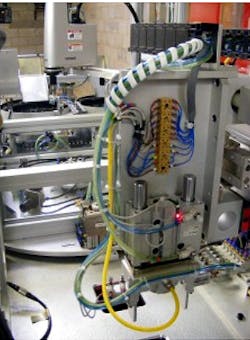Vision assisted robot automates spigot production
Engineers at Alphr Technology (Letchworth, UK) have developed a system for an automotive parts manufacturer to automate the assembly of molded plastic spigots.
In the past, assembly of the spigots had been a largely manual process, but when an increase in demand for the spigots meant that an additional production line was required, the company decided to investigate the possibility of automated assembly.
The engineers at Alphr Technology decided that a machine using conventional multi-axis pick-and-place technology would be complicated to design and build, inflexible, and ultimately difficult to maintain.
A solution based on a PLC-controlled rotary assembly station and an Omron Scara robot used in conjunction with a vision system and other Omron automation products would, however, be able to produce one completed part every 20 seconds as well as having the smallest possible footprint.
It would only require one operator who would need to load the parts into the machine. The rest of the process would be conducted automatically, including inspection, testing and the delivery of the finished part to either the pass or fail bins.
Even though the client had a wealth of experience using large, multi-axis robots, it had no previous involvement with Scara robots. Therefore, before making an investment in the new machine, the company needed assurance that it would perform as predicted.
To do so, application engineers from Omron used software to model the operation of the proposed assembly machine. This not only confirmed that the principle of operation of the machine was sound, but also that the required cycle times and efficiencies could be achieved.
In operation, the robotic system fits four compression limiters of two different sizes to the spigot. The limiters are accurately positioned and pressed into place to a precisely defined depth. Once fitted, they are retained with a specified force. Two Omron FQ vision sensors confirm that the limiters are all present and correctly positioned.
Lastly, a leak test is carried out on the completed spigot assembly to verify that the limiters have been fitted correctly and check the integrity of the part itself. To do so, the system pressurizes the part and tests it for leakage.
Depending on the results of the test, the part is transferred either to a pass bin or a fail bin, the latter being kept behind a locked door within the machine to ensure that defective parts can never be accidentally mixed with good products. Passed and failed parts are automatically counted, and the machine notifies the operator when the bins are ready to be emptied.
The new spigot assembly machine has now been working for several months. While the rate of production of the new machine is not substantially different from that of the manual assembly line, the percentage of reject parts has been greatly reduced, as the robotic placement of the compression limiters and the 100 per cent inspection by the vision sensors make it virtually impossible for incorrectly assembled parts to go forward to the final testing stage.
Related items on robotics from Vision Systems Design.
1. Vision guided robot enters risky areas
Engineers at Toshiba Corporation (Tokyo, Japan) have developed a tetrapod robot that is able to carry out investigative and recovery work in locations that are too risky for people to enter, such as Tokyo Electric Power Plant Fukushima No.1 nuclear power plant.
2. Robot vision to automate tree pruning
Purdue University (West Lafayette, IN, USA) researchers have received $6m in grants to automate one of the most laborious and costly jobs in vineyards and apple orchards.
3. Vision system produces crack free billets
Engineers at Buck Materials Handling Equipment (Rotkreuz, Switzerland) have developed a system known as the Mecana NT to ensure that billets of steel are free from cracks.
-- Dave Wilson, Senior Editor, Vision Systems Design
